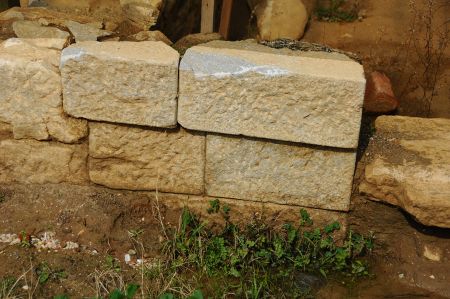Argilos - early Greek colony west of Strymonas
- Written by Portal Editor
We are on the way to the ancient Amphipolis, which is situated in an arch of the river Strymonas at the Roman Via Egnatia and which once was a major trading place, as a sign for the excavations of ancient Argilos appeared.
The ancient Argilos is located on the north Aegean, four kilometers west of the Strymonas Delta. It is one of the earliest Greek colonies in this area, founded in 655/54 BC in archaic time already. Today, excavations of the University of Montreal and the Greek Ephoreia of Serre have revealed extensive architectural remains, covering all periods of this era. The city flourished for about 300 years and was destroyed by Philip II, the father of Alexander the Great, in 357 BC. Only the Acropolis was preserved for another 100 years.
In the relevant literature, the foundation of Argilos dates back to 655/654 BC. Argilos is the earliest Greek colony on the Thracian coast. The settlers of Argilos occupied a privileged area and thus benefited from the trading activities along the Strymonas River and probably also from the Pangeion goldmines. Older authors rarely mention this side of settlement history, but the excavations show that the city enjoyed economic prosperity, at least until the founding of Amphipolis in 437 BC. In the last quarter of the 6th century BC, settlers of Argilos founded two colonies in the Thracian nuclear land, Tragilos and Kerdilion, a few kilometers further east of the city.
Herodotus said that in 480 BC, the Persian king Xerxès, together with his army, stopped at Argilos during his campaign, after crossing the Strymonas, and forced the inhabitants into his army. After the Persian defeat, Argilos became a member of the first Athenian confederation and paid 1.5 talents, a sum that proves that it was a rich city. The foundation of Amphipolis, which took control of the trade along the Strymonas, brought the end of the city of Argilos. Thucydides tells us that some inhabitants of the city, also called Argilists, took part in the founding of the city of Amphipolis, but also that the relations between the two cities quickly cooled, and during the Peloponnesian war the Argilists were even joining the army with leader Brasidas and were connected to attack Amphipolis.
An inscription from the Temple of Asklepios in Epidauros confirms that Argilos was an independent city in the fourth century. Like other colonies in the area, the city was built in 357 BC. by the Macedonian King Philip II. Historians thought that the city was then abandoned, but excavations of the University of Montreal and the Greek Ephoreia of Serres have discovered an important agricultural settlement on the Acropolis, which was existing until the years 350-200 before Christ. Roman or Byzantine ruins were discovered too.
The excavations of recent years reveal parts of a defensive defense, many private houses, public buildings and streets of the archaic and Hellenistic city, which were remarkably well preserved. Two important graves of the Macedonian type were also excavated, as well as ruins of rectangular tombs of the classical and Hellenistic period.
Please read as well:
Thasitic Peraia - settlement area of inhabitants of Thasos
Hammam - or Hamam - the steam bath of Agkistro
-
 Argilos-Greek settlement west of Strymonas
Argilos-Greek settlement west of Strymonas
Argilos-Greek settlement west of Strymonas
Argilos-Greek settlement west of Strymonas
-
 Argilos-Greek settlement west of Strymonas
Argilos-Greek settlement west of Strymonas
Argilos-Greek settlement west of Strymonas
Argilos-Greek settlement west of Strymonas
-
 Argilos-Greek settlement west of Strymonas
Argilos-Greek settlement west of Strymonas
Argilos-Greek settlement west of Strymonas
Argilos-Greek settlement west of Strymonas
-
 Argilos-Greek settlement west of Strymonas
Argilos-Greek settlement west of Strymonas
Argilos-Greek settlement west of Strymonas
Argilos-Greek settlement west of Strymonas
-
 Argilos-Greek settlement west of Strymonas
Argilos-Greek settlement west of Strymonas
Argilos-Greek settlement west of Strymonas
Argilos-Greek settlement west of Strymonas
-
 Argilos-Greek settlement west of Strymonas
Argilos-Greek settlement west of Strymonas
Argilos-Greek settlement west of Strymonas
Argilos-Greek settlement west of Strymonas
-
 Argilos-Greek settlement west of Strymonas
Argilos-Greek settlement west of Strymonas
Argilos-Greek settlement west of Strymonas
Argilos-Greek settlement west of Strymonas
-
 Argilos-Greek settlement west of Strymonas
Argilos-Greek settlement west of Strymonas
Argilos-Greek settlement west of Strymonas
Argilos-Greek settlement west of Strymonas
-
 Argilos-Greek settlement west of Strymonas
Argilos-Greek settlement west of Strymonas
Argilos-Greek settlement west of Strymonas
Argilos-Greek settlement west of Strymonas
-
 Argilos-Greek settlement west of Strymonas
Argilos-Greek settlement west of Strymonas
Argilos-Greek settlement west of Strymonas
Argilos-Greek settlement west of Strymonas
-
 Argilos-Greek settlement west of Strymonas
Argilos-Greek settlement west of Strymonas
Argilos-Greek settlement west of Strymonas
Argilos-Greek settlement west of Strymonas
-
 Argilos-Greek settlement west of Strymonas
Argilos-Greek settlement west of Strymonas
Argilos-Greek settlement west of Strymonas
Argilos-Greek settlement west of Strymonas
https://www.alaturka.info/en/greece/serres/3762-argilos-early-greek-colony-west-of-strymonas#sigProIdb2ca979158

